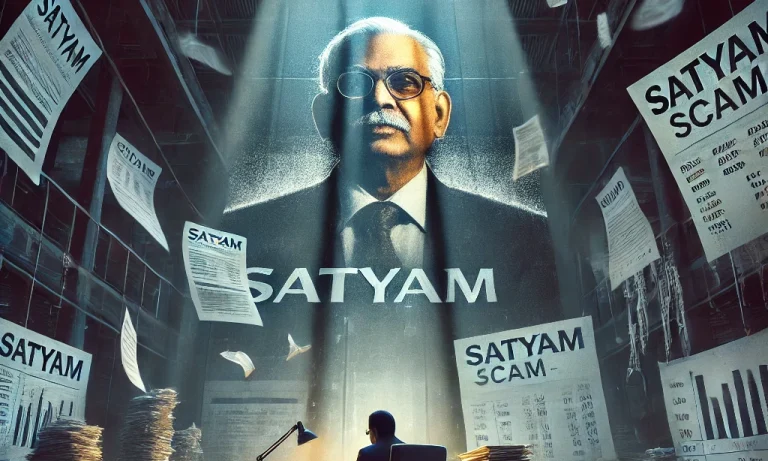The Satyam scam is one of the most gigantic accounting frauds India has ever seen. This occurred in 2009 when the founder and chairman of Satyam Computer Services, Ramalinga Raju, committed it. Satyam was brought down by this massive fraud, which at one time was one of the most successful IT companies in India. The business world of the country was shocked, and questions were raised over corporate governance, auditing practices, and the responsibilities of CEOs and boards of directors.
What is the Satyam Scam?
Satyam scam refers to a major financial fraud perpetrated in the year 2009. The chairman of the firm Satyam admitted to overstating the company’s financial statements over years. He lied about its sales, profits, cash balances, and number of employees. Moreover, he used the company’s funds for personal expenses. Altogether, the total worth of the fraud stood at around Rs 7,800 crore, considered India’s biggest corporate scam in business.
This fraud exposed various loopholes in corporate governance and auditing processes. It harmed the reputation of the Indian IT sector and resulted in severe losses to investors, employees, and customers. The scam raised serious questions about the lack of transparency, accountability, and ethical behavior in India’s business practices.
The Satyam Scandal: How Did It Happen?
The Satyam scam was planned and carried out over several years. Ramalinga Raju, along with his brother Rama Raju and other executives, inflated the company’s financial results to make it appear more successful than it was. They created fake bank statements, invoices, and customer data to mislead auditors, investors, and the public.
Between 2003 and 2008, Satyam’s stock price rose dramatically, making it one of India’s most valuable IT companies. The company received the Golden Peacock Award for Corporate Accountability in 2008. But behind the scenes, the company’s finances were not as healthy as they appeared.
In 2008, Satyam faced financial difficulties due to the global recession. This caused pressure from creditors and lenders. Ramalinga Raju made a desperate attempt to save the company by using its funds to acquire Maytas, a real estate company owned by his family. This decision led to a major backlash from shareholders and the board of directors.
Finally, in January 2009, Raju admitted to the fraud. He confessed that he had overstated Satyam’s assets by Rs. 7,800 crore, which was nearly 94% of the company’s total assets. He also admitted to inflating Satyam’s revenues by Rs. 5,040 crore, which accounted for 75% of the company’s reported revenue. Raju claimed that he had acted alone and that the company’s auditors and board members were unaware of the fraud.
Also read about FEDex Scam here.
How Did the Raju Brothers Commit the Scam?
The Raju brothers and a few top management employees worked together to cook the books and to dupe investors, auditors, and regulators. They created fake invoices overstated sales numbers and, on paper, inflated the company’s cash reserves. The group even created fake bank accounts and reported fictitious employees on the company payroll.
Raju utilized company resources on personal business opportunities mainly with Maytas, that he had a family business. The brothers in cahoots and their various colleagues also settled officials and clients as one form of cover. By his shrewd management, they were able to beat even auditors, namely the auditors Pricewaterhouse Coopers (PwC).
One of the most crucial points that led to the unraveling of the scam was when Raju attempted to purchase Maytas through Satyam’s funds. The deal infuriated the shareholders and board members, who suspected something was amiss. It was after much pressure that Raju confessed to the scam in January 2009.

Government’s Response to the Satyam Scam
The Satyam scam had serious consequences for the company, its employees, investors, and the Indian economy. The government took several steps to address the situation and improve corporate governance practices in the country.
Companies Act (2013)
- The Companies Act of 1956 was replaced by the Companies Act of 2013.
- Corporate fraud became a criminal offense under the new act.
- The act clearly defined the responsibilities of cost accountants, auditors, and corporate secretaries to disclose fraud.
- Auditor rotation was mandated: auditors must be replaced every five years and audit firms every ten years.
- The Board of Directors required a Director’s Responsibility Statement in the report.
ICAI (Institute of Chartered Accountants of India)
ICAI emphasized comprehensive reporting of fictional assets and contingent liabilities in audit reports.
SEBI (Securities and Exchange Board of India)
- SEBI enacted Regulations 2015, which included Listing Obligations and Disclosure Requirements.
- These regulations set guidelines for reporting actual and suspected fraud and disclosing events that could influence investors’ decisions.
Serious Fraud Investigation Office (SFIO)
- The Companies Act of 2013 granted SFIO statutory authority.
- SFIO investigates business and accounting fraud in India.
Corporate Governance Best Practices
Corporate governance reforms became an urgent priority, emphasizing transparency and accountability in business practices.
Who exposed the Satyam Scam?
It was an anonymous whistleblower who blew up the Satyam scam. He had sent emails to Satyam’s board member Krishna Palepu, stating that the balance sheets for three consecutive years had been manipulated, reflecting a financial position that was not genuine. Palepu forwarded those emails to the other board members and to PwC auditors. The alias of this whistleblower was Joseph Abraham.
The emails triggered a regulators’ and auditors’ probe that ultimately led to the confession and arrest of Raju. This was an important point in the case since it exposed the fraud.
The Role of PwC in the Satyam Scam
PricewaterhouseCoopers (PwC) was the external auditor for Satyam. The auditors were supposed to ensure that the company’s financial statements were accurate and in compliance with the law. However, PwC failed in its duty to detect the fraud. The firm overlooked several signs of irregularities and did not question the company’s inflated numbers.
Critics heavily criticized PwC for its role in the scam. As a result, the Indian government banned PwC from providing auditing services to publicly traded companies for two years. PwC also faced lawsuits and legal actions for its involvement in the fraud.
The Aftermath of the Satyam Scam
The Satyam scam had very wide implications. The stock of the company collapsed, and it incurred heavy losses for investors. Many companies laid off employees and canceled projects. Customers of the company also suffered because of the scandal.
To salvage the situation, the Indian government stepped in and made it possible for Tech Mahindra to acquire Satyam in 2012. Tech Mahindra IT company assumed management of Satyam and has successfully led the company back to its glory days.
The Satyam scandal, however, left a long-lasting mark on India’s corporate world. It brought serious questions about corporate governance, auditing practices, and the need for stricter regulations to prevent financial fraud.
Satyam Scam FAQs
Who is responsible for the Satyam scam?
Ramalinga Raju, his brother Rama Raju, and several top executives at Satyam are responsible for the scam. Critics also criticized PwC, the company’s auditor, for failing to detect the fraud.
Who manipulated the Satyam books?
The books were manipulated by inflating sales, profits, and cash balances. The perpetrators created fake invoices, bank statements, and customer data to deceive auditors and investors.
What happened to PwC after the Satyam scam?
Authorities banned PwC from auditing publicly traded companies for two years.. The firm also faced legal action and criticism for its role in the fraud.
Who acquired Satyam after the scam?
Tech Mahindra acquired Satyam in 2012 and helped the company recover its operations.
Why did Tech Mahindra acquire Satyam?
Tech Mahindra saw an opportunity to diversify and expand its business through the acquisition of Satyam. Tech Mahindra saw the company’s global reach and customer base as valuable assets.


